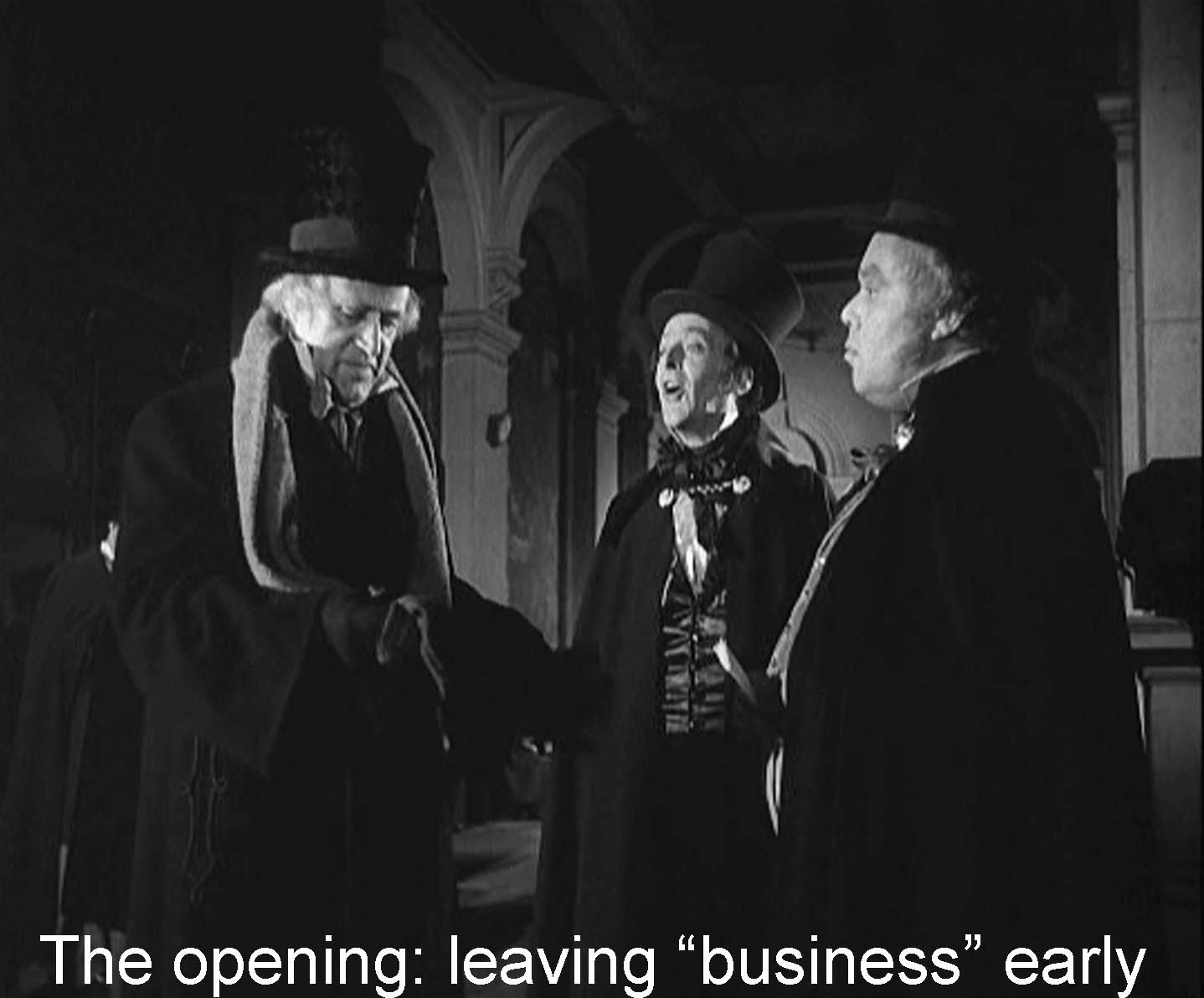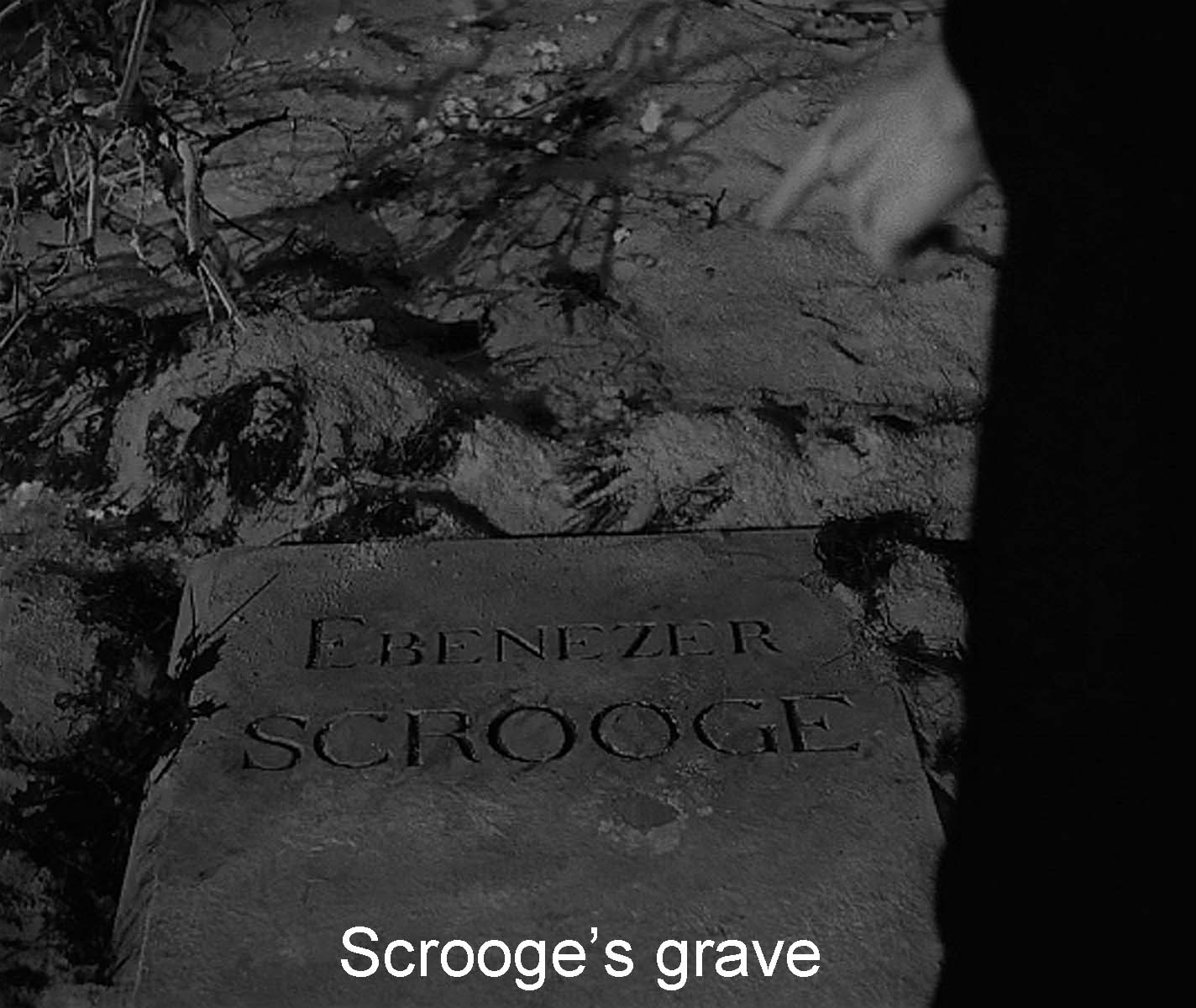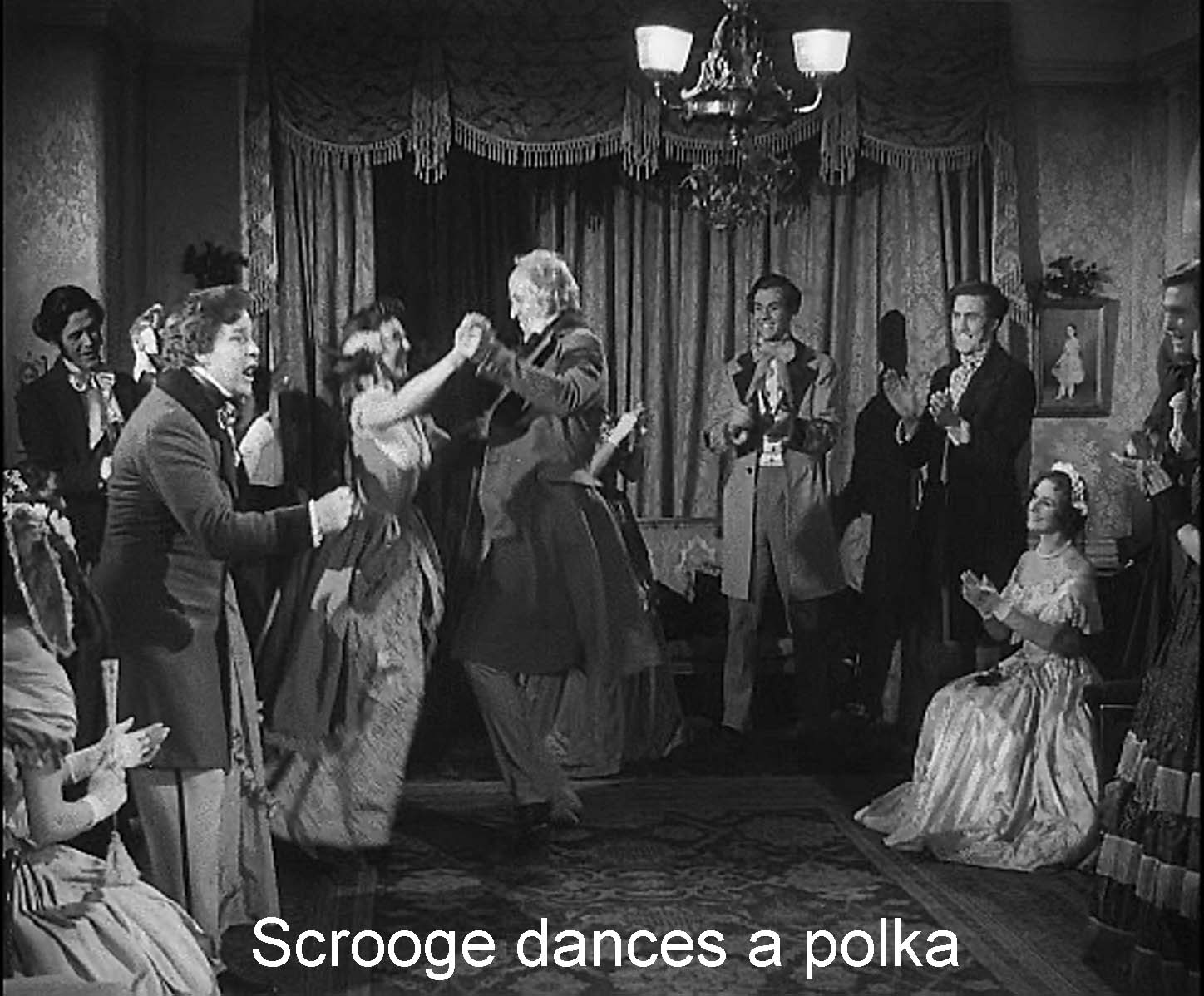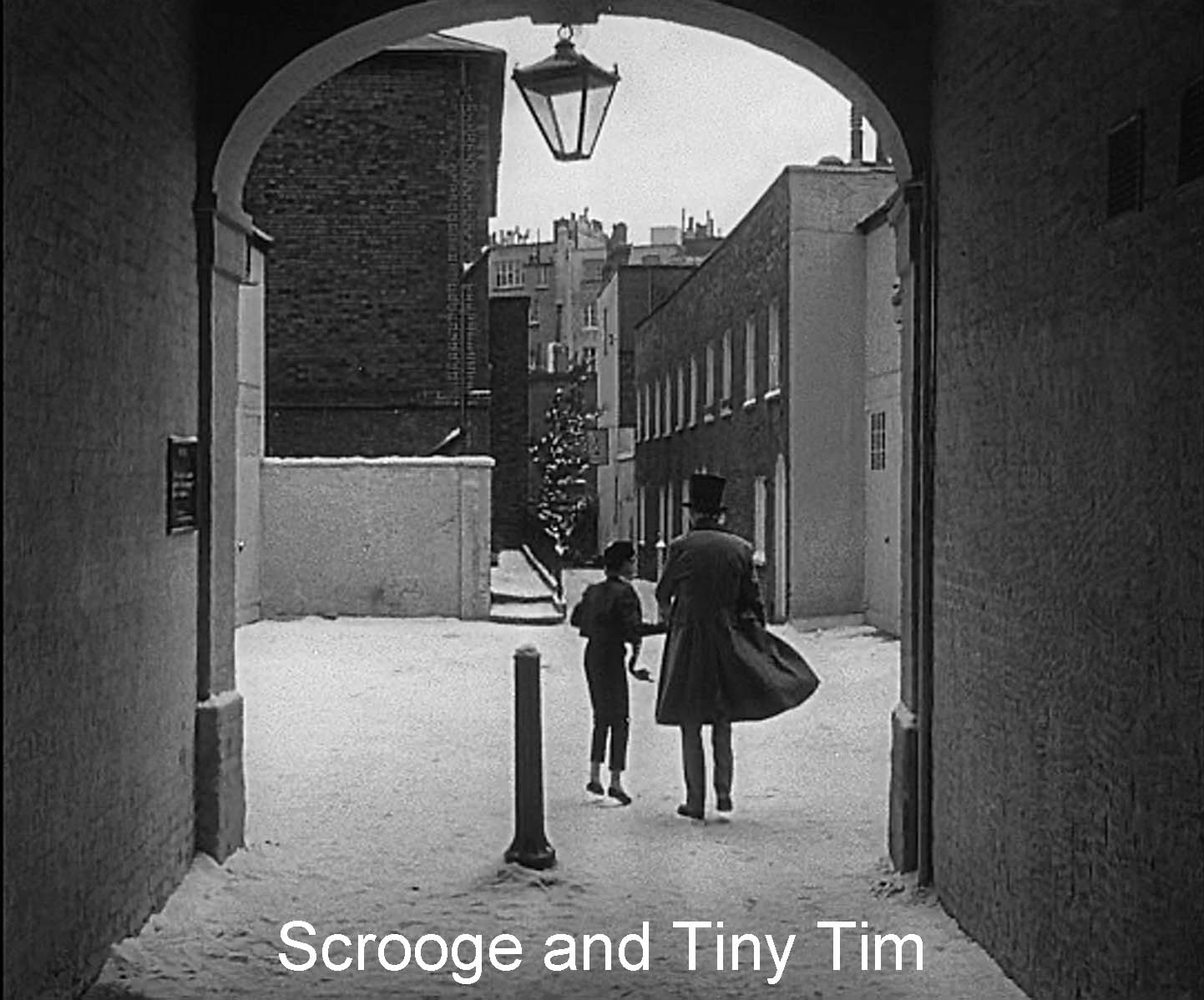A Christmas Carol shines as one of the brightest stars in the British tradition of ghost stories at Christmas. (Two other stars are The Turn of the Screw and Hamlet.) There are twenty-two films of A Christmas Carol (to say nothing of the radio and television versions or the animations like the Mickey Mouse cartoon starring Scrooge McDuck, the Mr. Magoo version, or the Bugs Bunny animation, with Yosemite Sam as Scrooge). This hugely popular film version of Dickens’ novel is again and again said to be the best, and I think it is. It is also often said to be the most faithful to the book, but it isn’t. The filmmakers, Noel Langley the scriptwriter and director Brian Desmond-Hurst, made plenty of changes, signaled by the film’s being called in the UK, not A Christmas Carol, but Scrooge. (And, of course, that highlights the film’s best feature, the wonderful portrayal of Scrooge by Alastair Sim).
Some of these changes are quite incidental, like giving Scrooge’s housekeeper (Kathleen Harrison) a name or changing the name of his fiancée from Belle to Alice—did someone not like the name? Others say more. I expect that you know the story. So popular, so done, is A Christmas Carol that I won’t do a plot summary. Wikipedia does that admirably for both film and novel. I want to focus on some of the many changes from novel to film, because I think they suggest ways of enjoying or understanding the film more.
The important changes by the filmmakers psychologize Scrooge. (Dickens himself wrote that the shortness of the novel cramped his development of the characters.) To explain Scrooge, the film greatly expands the Ghost of Christmas Past episode. These additions tell us, the audience, how Scrooge came to be the way we see him at the beginning of the film: surly, stingy, mean, cruel, and nasty in every way you can think of. Is this tactic a case of, tout comprendre c’est tout pardonner, to understand is to forgive? I’m not sure. It certainly makes the movie more complex (no pun intended) than the novel.
The novel has a scene in which Scrooge, as a young schoolboy left alone at school emptied by vacation, retreats mentally into a world of storybook characters. For Dickens, liking stories and imaginings is always a plus. The filmmakers develop that idea very briefly in the opening scene they added, by having Scrooge reject the fable of the grasshopper and the ant. “An ant is what it is. A grasshopper is what it is.”
The film’s version of the schoolroom scene omits the fantasies and makes him much older, perhaps sixteen. (This Scrooge is played by George Cole.) The dialogue focuses entirely on his sister Fan, also aged to a teen (Carol Marsh). As in the novel, she is to bring him home to a father who has finally reconciled himself to the son whose birth caused the death of his mother. Scrooge’s early years, then, in both novel and film, were passed without a mother and with a father who resented and exiled him.
In a wholly new scene added by the filmmakers, Scrooge, still in his apprenticeship at Fezziwig’s, proposes to his sweetheart Alice (the novel’s “Belle” played by Rona Anderson), and she accepts. He gives her a ring and swears eternal devotion. Here he is quite likable and, evidently, lovable, at least for Alice. There is nothing like this scene in the novel.
Then comes a scene in which sister Fan dies, stated in the novel, but dramatized in the film. She dies after giving birth to the nephew whom Ebenezer resents as his father resented him. It is this nephew whom he later treats harshly despite Fan’s dying wish that he take care of her son (a wish he may or may not have heard). And we see Scrooge “cut” an identified man at the death scene, presumably Fan's husband. She dies on Christmas Day, although I’m not sure that’s clear in the film. That would be another reason Scrooge hates Christmas.
The film now introduces a wholly new character, Jorkin (Jack Warner) and some new scenes, not in the novel. Jorkin comes to Fezziwig’s office and offers to buy Fezziwig out, stating that these are new days in the world of business, and there is now no room for anything except profit. Money is all that matters. With Fezziwig out of the room, he offers young Scrooge double his salary to come with him. And in the next scene Scrooge does, meeting young Marley (Patrick MacNee, of Avengers fame), a second clerk to Jorkin. And then Scrooge and Marley force Fezziwig out of his business, leaving the old man in tears. Again, this does not happen in the novel. Scrooge shows momentary regret or perhaps guilt for what he has done to Fezziwig, but he puts it aside to pursue “business”.
Now comes a scene both in the novel and the film, in which Alice “releases” Scrooge, saying he has changed and does not love her. He denies this, but she insists that he can’t love her because he is in love with money. It is she who rejects him (however wisely). She left him; he did not leave her. And he may have perceived this as punishment for what he did to Fezziwig.
Following on the scenes of Fan’s dying and Alice’s rejecting Scrooge, the film gives us another wholly new scene, nothing like it in the novel. Some company executives are meeting to try to cope with Jorkin’s embezzlements. With Jorkin’s connivance, Scrooge and Marley seize on this as an opportunity for them to take over another business through their own hard dealing. They leave the previous owners, Jorkin’s victims, pained and outraged. They themselves feel smug.
All this suggests “business,” but a business of sharp practices and indifference to the human wretchedness those practices cause. (Think of the banking practices leading up to the financial crisis of 2008.)
At this point, Scrooge has lost the two people he loved, Fan and Alice. I think the film suggests, even more than the novel, by its treatment of Scrooge’s loss of sister and sweetheart, that Scrooge turns to “business” as something he can rely on, more than anything else, really. Scrooge is grasping and stingy, yes, but I think he is hanging on to the one thing in his world that seems secure—money. And he can feel satisfied with himself for outwitting others.
I see this Scrooge as someone who had nothing to trust in his childhood except his sister Fan. But she dies. He finds love as a young man, but the woman he loves leaves him. Having lost the two people he loved, he turns to “business.” Business was something Scrooge succeeded at, something he could beat older men at (shades of his father?), and something he could hold onto, more than anything else, really. Profits and money, these are safe and sure. These he can grasp and keep and feel good about himself for. Presented as the film does, Scrooge becomes more understandable if not more forgivable.
In other words, Scrooge is not simply a pathological miser; he is a “man of business,” defined in the film as a man devoted to nothing but making profit and money. It is to make this point that the film introduces the completely new and quite important character, Jorkin, and his scenes. He provides a contrasting father-figure to the benevolent Fezziwig (“Money isn’t everything”), whom Jorkin and Fezziwig’s former clerks drive out of business, also not in the novel.
In the opening scene, added by the filmmakers, Scrooge tells two inquirers that Christmas is a “humbug” because it interferes with doing business. (A “humbug” is something designed to deceive.) The scene sets Scrooge up as someone who puts “business” before anything else. Thus Scrooge dismisses the two gentlemen soliciting for the poor with “It’s enough for a man to understand his own business, and not to interfere with other people’s. Mine occupies me constantly. Good afternoon, gentlemen!” And he feels quite satisfied with himself.
Scrooge’s tries to placate Marley’s ghost (Michael Hordern) with, “You were always a good man of business.” This is supposed to justify Marley’s misspent life, to which that miserable ghost replies, “Mankind was my business.” Later, Scrooge will ask the Ghost of Christmas Past what his “business” is with him, and the Ghost replies, “Your welfare.” This opposition, business vs. welfare (in many senses) centers the film just as it centered the novel, and it was very much in the air at the time the novel appeared.
Today, most of us are shocked by Scrooge’s favorable views of workhouses, prisons, treadmills, the extremely harsh Victorian Poor Laws, and Malthusian economics (letting the “surplus population” die). But these, I suspect, are simply the views of any man in the 1840s who is, one, totally focused on “business” to the exclusion of anything else and, two, conservative in his ideas, locked into the attitudes of the beginning of the century, closed to the reformist ideas of the 1840s and ’50s.
It is also worth noting that it was not until the middle of the nineteenth century that England revived the medieval celebration of Christmas. Before that the English rather frowned on Christmas. Both Puritan England and Puritan New England forbade outright the celebration of Christmas. Indeed, Dickens’ novel was one of the major things that hyped Christmas into the thirty-day buying spree it is today.
If we understand Scrooge as having adapted badly to his life’s events, the three ghosts then do what is essentially therapeutic work, freeing him from his fixation. Like therapists of today, the ghosts create change, or, more precisely, they enable their patient to change himself. Indeed, one dominant theme in the film, even more than in the book, is “change.” It has a double sense, one, commercial in the sense of “exchange” and the other psychological, the change in Scrooge’s personality around the loss of his sister and of Alice and then his positive change to the lovable Scrooge of the finale. The whole point of A Christmas Carol is that Scrooge has to change, and we also want Tiny Tim to change, but incidental characters change their attitudes as well, Scrooge’s housekeeper, his nephew’s wife, the men on the Exchange, and Mrs. Cratchit (Hermione Baddeley).
The first image—and this was added to the novel by the filmmakers— is the London Exchange or, as the characters call it, ’Change. The film brings that image back with the businessmen indifferent to Scrooge’s death in the Christmas Yet to Come section. And the film brings it back yet again in its closing words by having them spoken by Peter Bull, the rotund actor who, in front of the Exchange, delivered the opening question to Scrooge in the first shot.
Change takes place in time, and the film establishes this theme early. In the scenes added at the beginning, a businessman asks Scrooge, “Why are you leaving so early?” Scrooge replies by complaining about the Exchange closing early. Next, he refuses a debtor more time to pay. The three Ghosts of Christmas Past, Present, and Yet to Come are identified by time. The film introduces Jorkin’s speech about changing times and ways in the business world. But there are also incidental mentions of time, like Bob Cratchit (Mervyn Johns) or his daughter Martha being late. The name “Tim” itself comes very close to “time.” “I am too old,” is the excuse Scrooge offers for not changing.
His change itself has a mythic quality. Scrooge is a figure of old age and winter. He takes a supernatural journey, in part to an underworld (his own grave and death). From it, we get rebirth for him and new life for Tiny Tim (Glyn Dearman). Again, this comes from the book, but the filmmakers make it visual by identifying Scrooge’s former life with darkness and gloom, his new life with brightness and gaiety.
One other thing fascinates me in Desmond-Hurst’s Christmas Carol. Scrooge’s cure comes through cinema. The ghosts show him, in effect, movies. Perhaps they are 3-D or holograms or virtual reality: he can walk through scenes, and characters can walk through him. But he experiences these movies, and he is cured! Movies are good for us!
Forgive me my skepticism, but I am not one of those who believes that simply seeing movies (or reading great literature for that matter) makes us better people, either morally or more adapted in an evolutionary sense for reproduction and survival. I do think that thinking and talking about movies can perhaps make us wiser or better, as any serious thinking and talking can. (Hence this web site.) But as for this movie all by itself—it is so outrageously sentimental that I hesitate to call it a “good” or “great” film. Yet it never fails to bring tears to my eyes (even as I was writing this essay!) Why, oh why?
I think it has more to do with my own psychology than Scrooge’s. But it’s not just me. This film has been a sentimental favorite ever since it appeared, and I have no doubt it will continue to bring tears and joy to audiences for many Christmases to come. And that is an ultimate mystery, isn’t it? Successful films (or works of art in general) somehow enable each of us in our individual ways to make satisfying experiences from them. But how that happens and happens differently for each of millions of people, I don’t know and I don’t think anyone knows. It is a mystery even more mystifying than the three Ghosts of A Christmas Carol.









